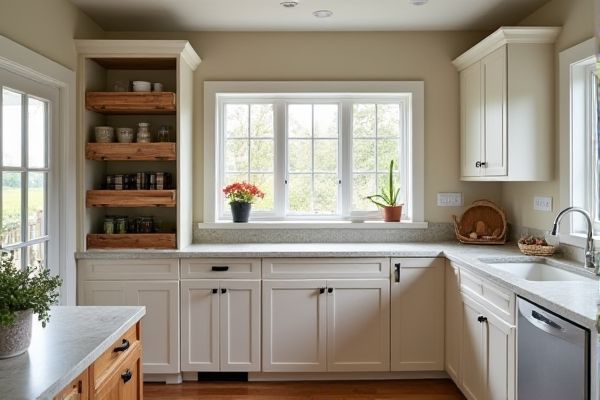
A kitchen pantry is designed primarily for storing food items and cooking supplies, while a utility pantry often serves a broader purpose, including housing cleaning products, appliances, and household essentials. Discover the key differences and decide which pantry best fits your home's needs by reading the rest of the article.
Table of Comparison
| Feature | Kitchen Pantry | Utility Pantry |
|---|---|---|
| Purpose | Stores food items, spices, and cooking essentials | Holds cleaning supplies, tools, and household items |
| Location | Located near or inside the kitchen for easy access while cooking | Often situated in laundry rooms, garages, or utility areas |
| Storage Type | Shelves and containers optimized for food preservation | Heavy-duty shelves and hooks for tools and cleaning products |
| Temperature Control | Usually climate controlled for food safety | Less strict temperature requirements |
| Organization | Organized by food categories and expiration dates | Organized by utility and function of supplies |
| Size | Typically medium to large, depending on kitchen size | Varies widely, often compact or multi-purpose |
| Access Frequency | Frequent daily use | Less frequent, occasional use |
Introduction to Kitchen Pantry and Utility Pantry
A kitchen pantry is a dedicated storage space designed to organize food items, cooking essentials, and small kitchen appliances, ensuring easy access during meal preparation. A utility pantry, on the other hand, typically serves a broader purpose by accommodating cleaning supplies, laundry items, and extra household tools alongside some kitchen goods. Understanding the difference between these two can help you optimize your home organization and streamline daily tasks efficiently.
Defining the Kitchen Pantry: Purpose and Features
A kitchen pantry is a dedicated storage space designed primarily for organizing food items, spices, and cooking essentials, ensuring easy access during meal preparation. It typically features shelving units, airtight containers, and labels to maximize organization and preserve food quality. Unlike utility pantries, kitchen pantries focus specifically on culinary needs rather than broader household storage.
Understanding the Utility Pantry: Functionality and Design
A utility pantry is designed for versatile storage, accommodating household appliances, cleaning supplies, and bulk food items, enhancing kitchen efficiency. Its layout often includes adjustable shelving, pull-out drawers, and designated spaces for specific utilities to maximize organization. Compared to a traditional kitchen pantry, it emphasizes functionality and accessibility, integrating seamlessly with laundry or mudroom areas for multitasking convenience.
Key Differences Between Kitchen and Utility Pantries
Kitchen pantries primarily store non-perishable food items, canned goods, and frequently used cooking ingredients, emphasizing easy access during meal preparation. Utility pantries focus on housing household supplies such as cleaning products, extra utensils, and bulk storage, often located near laundry or service areas. Spatial design varies, with kitchen pantries integrated into cooking zones for convenience, while utility pantries prioritize functionality and organization for maintenance tasks.
Storage Solutions: What Goes Where?
Kitchen pantries are designed primarily for storing food items such as canned goods, spices, grains, and dry ingredients, organized with adjustable shelves and airtight containers to maintain freshness and maximize space. Utility pantries focus on household essentials like cleaning supplies, extra cookware, and small appliances, often equipped with durable shelving and moisture-resistant materials to handle heavier, non-food items. Effective storage solutions separate consumables from utility items, ensuring convenience and safety by preventing cross-contamination and optimizing accessibility based on usage frequency.
Organization Strategies for Each Pantry Type
Maximize kitchen pantry organization by grouping canned goods, spices, and dry ingredients into clear, labeled containers for easy identification and accessibility. Utility pantries benefit from designated zones for cleaning supplies, tools, and bulk items, using stackable bins and adjustable shelving to maintain order and flexibility. Implementing tailored organization strategies enhances efficiency, making your kitchen and utility spaces functional and clutter-free.
Space Requirements and Placement Considerations
Kitchen pantries typically require more space as they store a wide range of food items and cooking essentials, often positioned close to the cooking area for easy access. Utility pantries are generally smaller, designed for storing cleaning supplies, appliances, and extra household items, and are usually located near laundry rooms or service areas. Placement of each pantry type depends heavily on the home's layout, optimizing functionality by minimizing travel distance to frequently used items.
Benefits of a Kitchen Pantry vs Utility Pantry
A kitchen pantry offers immediate access to frequently used ingredients and cooking essentials, enhancing meal preparation efficiency and reducing kitchen clutter. Utility pantries provide additional storage for bulkier items, cleaning supplies, and non-perishables, freeing up kitchen space and promoting organization. Choosing the right pantry type supports your home's functionality by tailoring storage solutions to your cooking habits and household needs.
Choosing the Right Pantry for Your Home
Choosing the right pantry depends on your household needs and available space; a kitchen pantry offers convenient access to daily cooking essentials, while a utility pantry provides extra storage for bulk items and cleaning supplies. Consider how you use your kitchen and whether you require easy reach to frequently used ingredients or ample room for larger items. Your choice will optimize organization and enhance kitchen efficiency based on your lifestyle.
Conclusion: Making an Informed Pantry Decision
Choosing between a kitchen pantry and a utility pantry depends on your storage needs and kitchen layout. A kitchen pantry offers convenient access to everyday cooking essentials, while a utility pantry provides space for bulk items and household supplies. Prioritize your habits and available space to make an informed pantry decision that maximizes organization and efficiency in your home.
 homyna.com
homyna.com